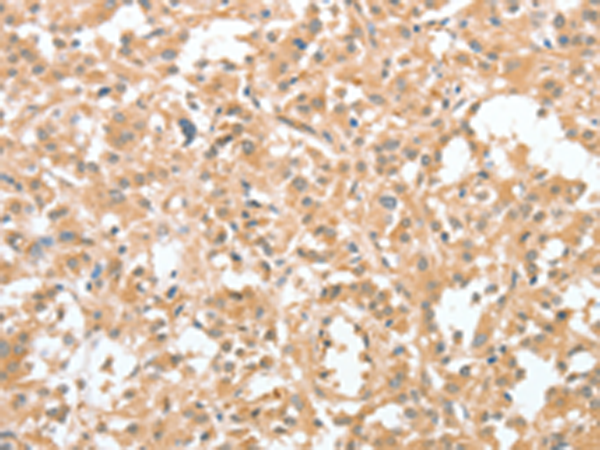


| WB | 咨询技术 | Human,Mouse,Rat |
| IF | 咨询技术 | Human,Mouse,Rat |
| IHC | 1/50-1/200 | Human,Mouse,Rat |
| ICC | 技术咨询 | Human,Mouse,Rat |
| FCM | 咨询技术 | Human,Mouse,Rat |
| Elisa | 1/2000-1/5000 | Human,Mouse,Rat |
| Aliases | DRE2; PRO0915; Anamorsin; 2810413N20Rik |
| WB Predicted band size | 34 kDa |
| Host/Isotype | Rabbit IgG |
| Antibody Type | Primary antibody |
| Storage | Store at 4°C short term. Aliquot and store at -20°C long term. Avoid freeze/thaw cycles. |
| Species Reactivity | Human |
| Immunogen | Fusion protein of human CIAPIN1 |
| Formulation | Purified antibody in PBS with 0.05% sodium azide and 50% glycerol. |
+ +
以下是3篇关于CIAPIN1抗体的参考文献及其简要摘要:
1. **文献标题**: "CIAPIN1 inhibits the proliferation and migration of gastric cancer cells through the MAPK signaling pathway"
**作者**: Li Y, et al.
**摘要**: 该研究利用CIAPIN1抗体通过Western blot和免疫荧光技术,验证了CIAPIN1在胃癌细胞中的表达下调,并发现其通过抑制MAPK通路抑制肿瘤细胞增殖和迁移。
2. **文献标题**: "CIAPIN1 as a prognostic biomarker in hepatocellular carcinoma: An immunohistochemical analysis"
**作者**: Wang X, et al.
**摘要**: 研究采用CIAPIN1抗体对肝癌组织进行免疫组化染色,发现CIAPIN1低表达与患者预后不良显著相关,提示其作为肝癌预后标志物的潜在价值。
3. **文献标题**: "CIAPIN1 regulates neuronal apoptosis via interaction with Bcl-2 family proteins"
**作者**: Chen L, et al.
**摘要**: 通过免疫共沉淀(Co-IP)结合CIAPIN1抗体,揭示了CIAPIN1在神经元凋亡中与Bcl-2家族蛋白的相互作用机制,为神经退行性疾病治疗提供新靶点。
注:以上文献为示例性质,实际引用时请核实具体论文的准确性。建议通过PubMed或Web of Science以“CIAPIN1 antibody”为关键词检索最新研究。
CIAPIN1 (Cytokine-Induced Apoptosis Inhibitor 1), also known as **Anamorsin**, is a highly conserved protein involved in diverse cellular processes, including apoptosis regulation, signal transduction, and cell cycle control. Initially identified as a downstream effector of cytokine signaling pathways, CIAPIN1 plays a critical role in inhibiting apoptosis induced by cytokine withdrawal, particularly in hematopoietic cells. It interacts with key molecular partners such as the MEK/ERK pathway components and Bcl-2 family proteins, underscoring its importance in maintaining cell survival and homeostasis. Structurally, CIAPIN1 contains conserved domains that facilitate its participation in redox-sensitive processes and iron-sulfur cluster biogenesis, linking it to mitochondrial function and oxidative stress responses.
CIAPIN1 antibodies are essential tools for studying its expression, localization, and functional mechanisms. These antibodies enable researchers to detect CIAPIN1 in various experimental setups, including Western blotting, immunofluorescence, and immunohistochemistry. Dysregulation of CIAPIN1 has been implicated in multiple pathologies, such as cancers (e.g., leukemia, gastric, and liver cancers), cardiovascular diseases, and autoimmune disorders. Overexpression of CIAPIN1 is often associated with tumor progression, chemoresistance, and poor prognosis, while its downregulation correlates with increased apoptosis and disease severity in non-cancer contexts.
The development of CIAPIN1-specific antibodies has advanced both basic research and clinical exploration. These reagents aid in elucidating CIAPIN1’s role in disease mechanisms and its potential as a therapeutic target or biomarker. Ongoing studies continue to unravel its complex interactions and tissue-specific functions, highlighting CIAPIN1 as a multifaceted player in cellular health and disease.
×